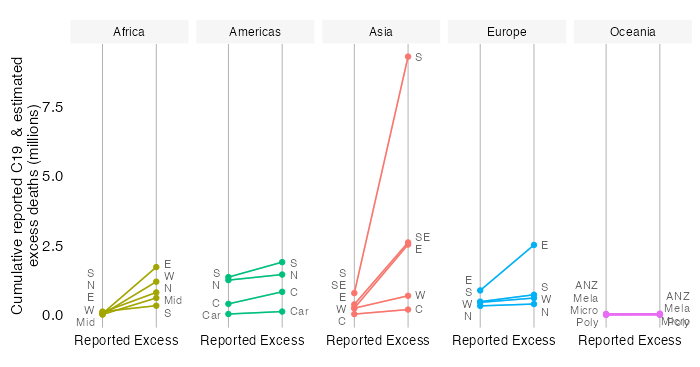
Pandem-ic currently covers three themes: pandemic severity, the scale of the Omicron escalation, and global vaccine equity.
The first theme delves into the understated severity of the pandemic in developing countries, highlighting the gap between official data and the reality of excess mortality. Pandem-ic addresses pressing questions on how COVID-19 compares to pre-pandemic mortality patterns, the impact of population outliers, and why this remains a developing country pandemic.
The second theme explores the unprecedented scale of the Omicron escalation, examining the latest global patterns on newly confirmed cases and its unequal impacts across countries. Pandem-ic provides insights on the implications of the sheer scale of the escalation for the future course of the pandemic.
The third theme focuses on the unmet need for global vaccine equity, emphasizing the persistent gaps in vaccine coverage, particularly in lower-income countries. Pandem-ic asks critical questions on how to think conceptually about global vaccine equity, the latest status on primary and booster vaccination, and how well the global priority group is protected.
Delve into the reality of the pandemic’s understated severity in the developing world, as official data on pandemic mortality has failed to paint the full picture. Initially, the claim was made that COVID-19 would leave the developing world “unscathed,” and later that the pandemic had been “mild” in countries with young populations, leading to the belief that vaccines were unnecessary. However, a broader examination reveals the true impact of the pandemic, especially in developing countries.
By using the concept of excess mortality, we can take a comprehensive look at the true and total impact of the pandemic. The chart above reveals our best guess of the per capita mortality impact on the developing world. Middle-income countries – both lower and upper middle – have been hit hard despite having much younger populations than high-income countries, whereas low-income countries have much higher rates than the official numbers suggest.
Our posts on pandemic severity tackle critical questions to deepen our understanding of the pandemic’s impact:
Why has the pandemic been a developing country pandemic, and has it always been this way?
Stay up-to-date with the latest developments on pandemic severity by checking out our most recent posts, almost all of which are updated daily:
We’ve also compiled a selection of external articles and blogs on pandemic severity that have been republished on our platform. These resources provide additional perspectives and insights, helping to broaden our understanding of the pandemic’s impact:
Discover the previously unseen scale of the Omicron escalation, the second theme of our platform. Since mid-December 2021, Omicron has swept across the globe, leading to an unparalleled surge in the number of confirmed cases, initially accompanied by Delta. Pandem-ic documents this escalation and sheds light on its unequal impact on countries. We explore the implications of the sheer scale of the escalation, offering insights into the future course of the pandemic.
The chart above vividly portrays the scale of the Omicron escalation. It illustrates the ratio of the latest peak in cases and deaths per capita compared to the earlier peak before November 1, 2021. We can see that the surge in cases has been extraordinary, and the impact on mortality, while not as severe as before, is still significant. It’s worth noting that if we could count all infections accurately, the scale of the escalation would be even more striking.
In light of the stark reality of the pandemic’s impact, we are left with several questions:
What are the implications of the scale of infection for the future course of the pandemic, and how can we best prepare for what’s to come?
We explore these critical questions in the following posts:
The third theme of our platform is the urgent need for global vaccine equity, which has been a key focus since our inception. Despite some progress, the road to achieving vaccine equity remains long and challenging, as persistent gaps in coverage continue to highlight. Lower-income countries continue to suffer the greatest shortfalls in primary vaccination. Meanwhile, booster programs are being rolled out globally, yet they seem to follow the same patterns of inequality that marked the primary vaccination campaign.
The unvaccinated world is huge – as of today, 2.2 billion people have not yet received a single COVID-19 vaccine shot. Our cartogram above depicts where the unvaccinated live, with land masses distorted to represent the headcount of those without vaccines. This illustrates the main challenge in achieving global vaccine equity in the absolute: Sub-Saharan Africa and South Asia. However, in per capita terms, the challenge is most intense in Sub-Saharan Africa, as the colors of the chart suggest.
At our platform, we explore the issue of global vaccine equity, tackling a range of questions, including:
What are the characteristics of countries that perform well or less well in vaccine distribution?
Check out our daily updated posts on the global vaccine equity:
See also the following articles on global vaccine equity published originally elsewhere and republished here:
We believe that a deep understanding of the interconnectedness of global health issues is important to navigating this pandemic and beyond. Our three thematic areas – pandemic severity, Omicron escalation, and global vaccine equity – may seem separate at first glance, but they are inextricably linked. Our posts explore these connections, highlighting for instance how the need for vaccine equity is accentuated by the severity of the pandemic in the developing world, and how the transmissibility of Omicron has highlighted the importance of global collaboration in managing the virus.
We invite you to explore our platform and join the conversation. Your comments and suggestions are welcome!